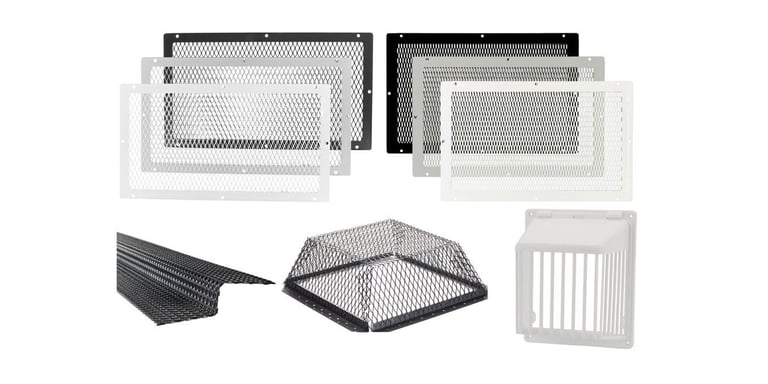Subscribe now and get our latest blog and video content delivered straight to your inbox.
5 Reasons Pest Control Operators Should Offer Wildlife Exclusion

Feb 5, 2024

The pest control and wildlife control worlds are typically treated as separate entities. Pest control operators use specialized, industry-specific knowledge in their jobs, and they usually feel that an outsider — like a wildlife control operator — can’t just step in and start performing pest control operations with no training. Wildlife control operators tend to feel the same way.
While this is generally true, and both groups tend to stick to their own specialty, there is a specific category of wildlife control — wildlife exclusion — that provides a great opportunity for pest control operators to dip their toes into the wildlife world.
At HY-C, we manufacture several wildlife exclusion devices under our HY-GUARD EXCLUSION brand name, and we firmly believe that wildlife exclusion is a perfect addition to any pest control operator’s toolbelt.
So, in the interest of helping those in the pest control world round out their integrated pest management skills, in this guide, we’re going to make the case as to why pest control operators should add wildlife exclusion to their offering.
By the time you’re finished here, you’ll understand what wildlife exclusion is, how it can benefit pest control operators, and whether or not you should start offering wildlife exclusion solutions to your customers.
What is Wildlife Exclusion?
Pest control and wildlife exclusion aren’t that different from one another. But while pest control operators tend to think of wildlife exclusion simply as the removal of rats and mice from homes, there’s a bit more to it than that.
Rather than baiting, trapping, and releasing critters who have already gained access to a home, wildlife exclusion deals with preventing animals from getting into a home in the first place.
Wildlife control operators install exclusion screens and guards on vulnerable openings on houses (usually vents) to stop critters from gaining access to chimneys, attics, foundations, or soffits.
5 Reasons Why Pest Control Operators Should Consider Wildlife Exclusion
As a pest management professional, you may never have considered adding wildlife exclusion to your toolkit. Whether you’ve been in your job for decades or months, you may feel unprepared to step into the world of wildlife control.
Wildlife exclusion may not require as many hurdles as you might expect, though. In fact, we’re come up with 5 reasons as to why wildlife exclusion may just be the perfect addition to your pest management business.
1. You Have Prerequisite Wildlife Exclusion Skills That Most People Don’t
We’ve already covered why only professionals should install wildlife exclusion products. Some of the main reasons for this are:
- Working from heights (like roofs) is dangerous
- Wildlife laws vary widely
- Understanding animal behavior requires training
The good news for you as a pest management professional, though, is that you don’t need to worry about these limitations. You likely have experience working on roofs, you probably already understand local critter and pest behaviors, and you’re no doubt familiar with your local wildlife laws.
You also understand the spots where pests tend to enter homes and how to get them out. And even if you are lacking in one of these areas, your training as a pest control operator will make it easy for you to catch on to these wildlife exclusion prerequisites.
In short, it’s much easier for you to jump into wildlife exclusion than anybody else. You may not realize it, but you already have many of the required skills.
2. There’s an Increasing Intolerance for Pests in Homes

It’s tough to show any data on this, but if you’ve been in the pest or wildlife control industries for a while, this is a fact that you can kind of just “feel”.
20 years ago, if somebody had a mouse in their house, they’d buy a mouse trap. If a raccoon made a nest under their porch, they’d flush it out. Pest and wildlife control were still around, of course, but more people felt comfortable taking small to medium critter control issues into their own hands.
Nowadays, homeowners — especially new, young homeowners — are more likely to call a professional to remove anything and everything from their homes.
This intolerance toward pests combined with a hesitancy to deal with them means that homeowners are now more likely to pay for a one-time, permanent, preventive solution like wildlife exclusion. And, as we’ve covered, you have the prerequisites to start installing these devices yourself.
3. There’s an Increasing Intolerance against Pesticides and Insecticides

Deserved or not, there’s no denying that chemical agents — especially those used on foods or in homes — are facing more and more scrutiny with each passing year. Government agencies have been creating laws about what can and can’t be used for decades, and the regulations get even more complex on a state-by-state basis.
And while governments cracking down on pesticides is not new, concerns among homeowners over the kinds of chemicals used on their property have been on the rise. As millennial and gen-z homeowners start accounting for a larger portion of the housing market, they bring their environmental concerns with them into their homes.
Whether you think these health and environmental concerns are warranted or not, there’s no denying that they exist. And it’s tough to change peoples’ minds about them.
Thankfully, wildlife exclusion devices don’t face this kind of scrutiny. These simple metal screens allow you to offer an environmentally friendly, chemical-free critter solution, should your customer request one. They’re effective, they’re permanent, and they’re humane, too.
4. Wildlife Exclusion will Generate More Revenue for You
Most pest control services are subscription-based. Whether your company’s contracts are based on a per month or per visit basis, the same principle applies: homeowners pay you to spray for bugs throughout the year, and you service their home for the length of the contract.
Of course, bugs aren’t the only pest-related threat to your customers’ homes. Birds, raccoons, squirrels, rats, mice, snakes — the list differs depending on where your customers live, but the idea remains the same: wildlife wants to take shelter from the elements (and other wildlife) in the homes you serve.
Wildlife exclusion devices can be offered as a preventative, add-on service to your existing pest control offering. You can warn your customers about vulnerable spots on their homes like chimneys, foundation vents, soffit vents, bathroom vents, and dryer vents, and provide one-time solutions that will raise your average ticket prices.
Of course, the downside to this is that you’ll only be able to do it once. Unlike most pest control solutions which are charged monthly or annually, wildlife exclusion devices are a one-time charge. Still, though, it’s better to be able to offer the solution once than never being able to offer it at all.
5. You Already Have a Pre-Qualified Wildlife Exclusion Client Base

This is perhaps the most compelling reason why your pest control business should start offering wildlife exclusion products: every client you’ve served so far has had a pest problem. Every home you’ve visited is owned by someone who has shown that they are willing to pay money to keep critters away.
Your clients are exactly the kind of people who will want wildlife exclusion devices on their homes. If you contact them and offer an array of preventative exclusion solutions on top of your current pest control package, you’re very likely to have success.
How Do You Start Offering Wildlife Exclusion Solutions?
By now, it should be pretty clear that wildlife exclusion is a fantastic opportunity for pest management professionals. Pest control operators have the prerequisites to handle and install the products, industry trends are shifting toward exclusion-based solutions, and pest control companies have already done the legwork of building the perfect customer base for wildlife exclusion.
So — what’s next? If you’re interested, how do you get started?
The best thing to do is find out what kinds of exclusion products are available and where (and how) to install them. Our HY-GUARD EXCLUSION line was designed from the ground up to account for virtually every wildlife exclusion situation.
From roof to foundation and everything in between, the HY-GUARD line is essentially a comprehensive array of all things exclusion. If you’re interested in offering wildlife exclusion solutions for your pest control clients, take a look at what’s in the HY-GUARD EXCLUSION portfolio.
From there, you’ll be able to decide which solutions make the most sense to add to your business’s toolkit, and you’ll be ready to start sealing critters out of your customers’ homes.
